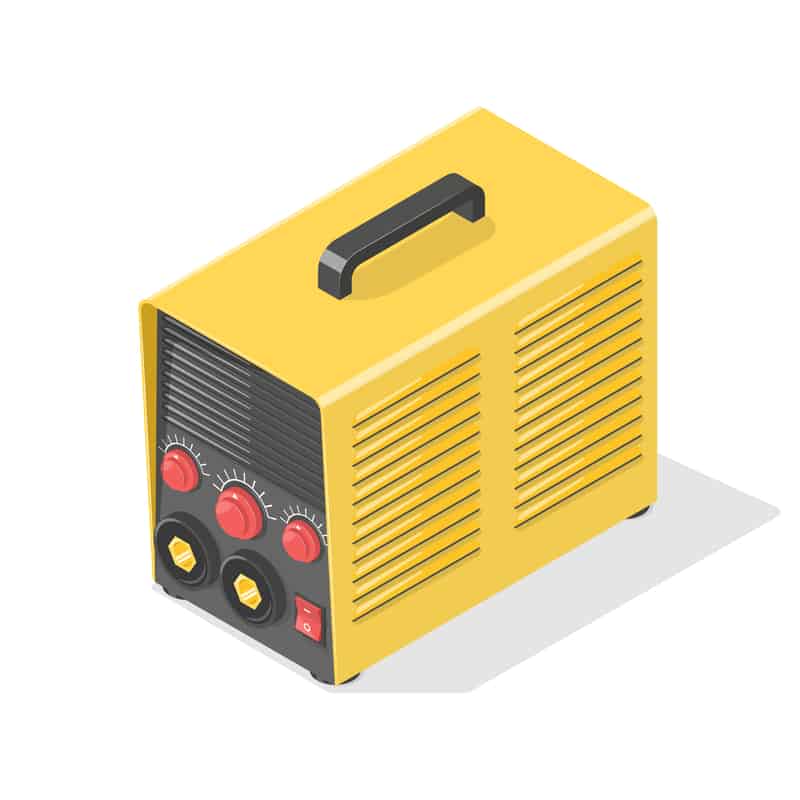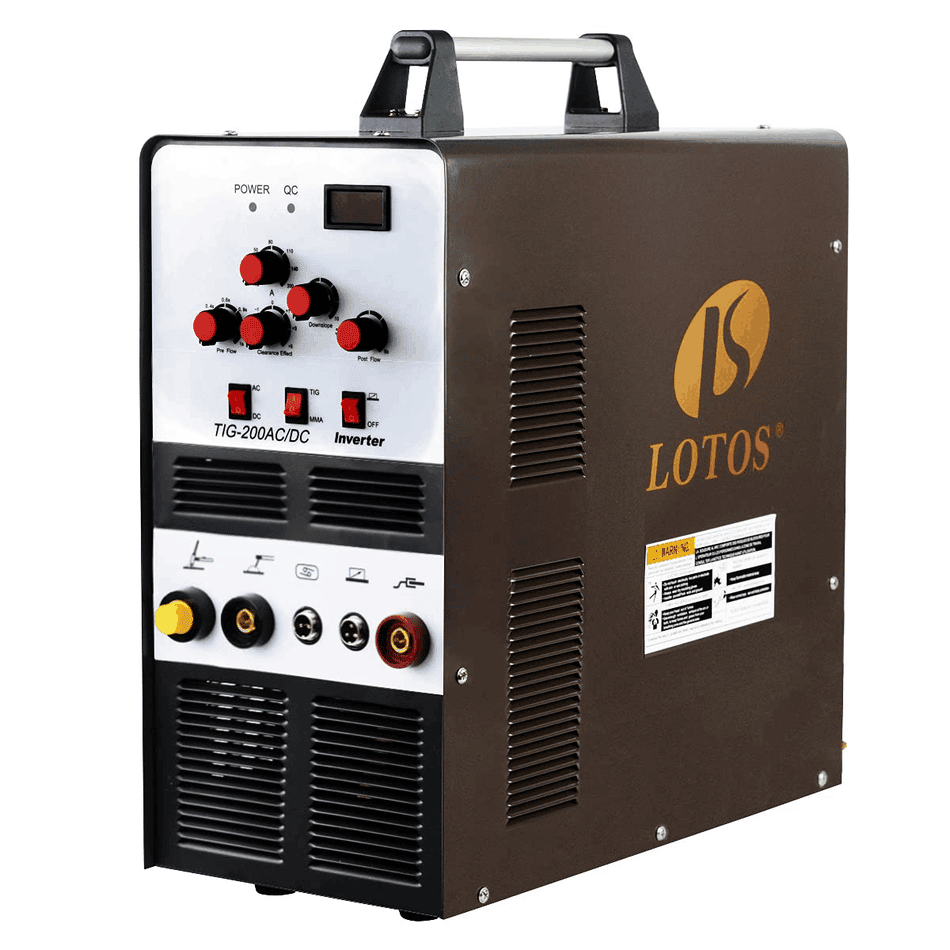“This post contains affiliate links, and I will be compensated if you make a purchase after clicking on my links.”
An internet search for TIG welders reveals dozens of machines and a bewildering array of features. The prices for TIG welders range from the cost of a night on the town up to welders that cost as much as a small car. How can a beginner find the best, most affordable TIG welder?
What are the nine best TIG welders for beginners? Before you buy your first TIG welder, it pays to think about why you want a TIG welder and what you might weld. Are you interested in learning TIG for its own sake, or are you a weekend warrior who wants to build a variety of projects? Will you be welding aluminum, thick steel, or rusty metal?
The answers to these questions will determine which is right for you.
TIG Specialist
If your goal is to learn TIG welding, you might be better off with a more expensive TIG-only welder that allows lots of flexibility in terms of metal type and thickness. The higher degree of control you get with a TIG-only welder lets you make fine adjustments for metal type and thickness. It can even help you weld different metals together.
General Welding
If your goal is to join metal for projects the best way possible, consider a multi-process welder that can MIG or arc weld in addition to TIG. Having the ability to switch between welding processes lets you set up the best weld for every situation.
Different jobs work better with different welding processes. TIG makes pretty welds but requires the metal to be absolutely clean. Arc welders (also called stick welders) don’t make a pretty weld but can handle rusty or dirty metal with the right rod. Arc welders also work better outside than gas-shielded welders. MIG welders tend to be the fastest, which can be important for larger jobs.
Which Metals?
You should also give some thought to which metals you want to weld. TIG welding aluminum requires the use of alternating current. The cheapest TIG machines can only weld with DC, so saving money won’t help you if you want to weld aluminum. Even if you’re a beginner, it’s better to spend a little more for a welder that can do what you want that to “save” money on a welder that you can’t use.
If you want to weld steel only, you should give some thought to how much power you need. TIG welding steel requires about one amp per 0.001 in thickness of steel. This table lists some common types of welding with the thickness of the metal and amps needed to weld it.
| Type of Weld | Metal Thickness | Amps Needed |
| bicycles or lawnmowers | 1/16 | 62.5 |
| engines | 1/16 to 1/8 | up to 125 |
| structural steel | 3/8 and more | 187.5 |
| auto body repair | up to 3/16 | 187.5 |
| general repair | 3/16 to 1/4 | up to 250 |
| trailers and fencing | 1/4 to 5/16 | 250 to 312 |
| farm and ranch | 5/16 to 3/8 | up to 375 |
Entry-level TIG welders max out at 200 to 225 amps, so if you intend to repair heavy material, build trailers or fences, or fix farm equipment, an entry-level TIG welder won’t work. Also, TIG welding is hard to do outside or on dirty, rusty metal… If you are building a fence, repairing farm equipment, or welding greasy engine parts, arc welders are much better suited to the task.
Durability
Finally, think about how much you want to weld. Less-expensive welders sometimes fail under heavy workloads. If you are welding every day, it might be cheaper to buy an expensive welder that will last than a series of disposable welders that break down.
TIG Welder Features
The price of a welder depends on a number of features. We have already touched on amperage. That is a measure of how much energy the welder puts out. More amps mean a hotter weld, which means you can join thicker metal. You also need more amperage to weld metals that are good conductors, like aluminum and copper. There are other features that impact welder prices, as well.
Power Source
TIG welders may use 110-volt current, 220-volt current, or both. Standard household current is 110 volts. Usually, the only 220-volt circuits in a home are for clothes dryers, ovens, and heaters. As a rule, welding with 110 volts doesn’t allow you to get the full amperage that the welder can put out. You need a 220-volt circuit to get maximum power from your welder. That usually means a call to an electrician.
Pro tip: most household circuits are either 15-amp or 20-amp. 110-volt welders need a 30-amp breaker. If you find that the welder trips the circuit breaker often, you need a bigger breaker. If you have to call an electrician anyway, go ahead and have him install a 220-volt circuit so your welder can really run.
Duty Cycle
The duty cycle tells you how many minutes your welder can run without overheating. It is the percentage of time your welder can be on and off at a given amperage setting. The calculation is:
Minutes on / (minutes on +minutes off) = duty cycle %
A welder with a 20% duty cycle can run for two minutes, then needs eight minutes to cool (2/[2+8]=20%). This is a low-power cycle. Duty cycles of 40-50% are medium, while duty cycles of 60-80% are high. There are machines with 100% duty cycles, but they are heavy-duty industrial machines. Factories need machines that can run non-stop for eight hours, but home welders don’t.
Less expensive welders have shorter duty cycles. This isn’t a problem for weekend warriors, but it can be if you are going to be welding a lot.
Pulse Welding
Some TIG welders have the ability to pulse weld. That means the amperage goes up and down several times per second in quick pulses. Pulse welding keeps the weld pool liquid with less total heat. Less total heat means the metal won’t overheat as quickly, preventing warping and oxidation. Pulsing is particularly helpful if you are welding very thin material.
Direct or Alternating Current
Polarity is the direction that the electric current flows. Direct current (DC) keeps the polarity moving in the same direction at all times, while alternating current (AC) flips the polarity quickly back and forth. Steel is always welded with DC. Aluminum is usually fused with AC because the polarity flips help break up aluminum oxide on the metal surface. The aluminum oxide can reduce weld quality if left alone.
The least expensive TIG welders are DC-only, so you should avoid them if you know you will be TIG welding lots of aluminum. If you don’t want to spring for AC ability, the other option for welding aluminum is to use a multi-process welder. MIG and arc welders can use a rod with flux in it that will scrub off the oxide.
Arc Start
More expensive TIG welders have a no-touch arc start. That increases the amperage temporarily at the start of the weld to crack an arc without touching the metal. No-touch arc start helps keep the tungsten electrode cleaner than the traditional method of scratching the electrode across the metal. The no-touch start comes at a higher cost, though.
Price Points
We looked at welders in several different price points to determine the best, cheapest TIG welder for beginners. The cheapest welders are lightweight imported machines. These are good for brand-new metal workers, for people who have an existing shop and want to add TIG, and for people who want to be able to take a TIG welder to other places. They aren’t as good for TIG specialists or everyday welders.
The middle price range adds lots of features compared to the entry-level welders. Depending on the model, these include pulsed welding, AC ability, or no-touch arc start. Some have the ability to weld with MIG as well as TIG. Welders in this price range are able to weld aluminum much better than the low-cost welders.
The most expensive welders come with lots of features. They also come from old, established brands that have a reputation for quality and service. If you want to weld every day for years to come, the cheapest TIG welder is a name-brand box from an established company like Miller, Lincoln, or Hobart. It will be cheaper to buy one of these once that to pay for a series of imported welders that break down.
Low-Cost Welders
The first price point for TIG welders are low-cost machines. These are good for folks who just want to try out TIG welding to get a feel for it, and for people who need to be able to take a welder with them to work at a buddy’s house. These machines are not everyday welders, and some people will weld enough to wear them out. If you want to try TIG but you’re not looking to spend a fortune, check out these welders.
1. Amico Power TIG-185 TIG / Arc Welder
At just nineteen pounds, the Amico TIG-185 is the smallest welder reviewed. It is also the least expensive at the time of writing. The maximum amperage is 180, and the duty cycle is 60% at full load. It is a TIG / stick combo machine that runs on 110 and 220-volt current.
Things we like:
- Nice price
- Portable
- Flexible; can run TIG and stick
- High-frequency start to extend electrode life
- Comes with everything you need except a gas regulator for the shield gas
- Simple controls make it easy to set up
Things we don’t like:
- Won’t work with a foot pedal
- Simple controls limit flexibility
- Won’t weld AC, so you can’t do much with aluminum
- Imported welders don’t have a great reputation for durability or ease of repair
Best for:
This welder is great for beginners who want to start welding or experienced welders who want to try TIG. With the lightweight and flexible power input, it’s also useful for taking to your buddy’s house to help him out on projects. It’s not for thick metal or welders looking for a machine to run every day, though.
2. Yeswelder TIG-205DS TIG / Arc Welder
The Yeswelder TIG-205 is another small combo machine that will weld with TIG or stick. It has a 60% duty cycle and will weld up to 200 amps. It will operate on either 110 or 220-volt current. This is another lightweight machine, but with a little more power than the Amico TIG-185. The extra amperage lets you weld steel that is about 1/32 of an inch thicker.
Things we like:
- It comes with everything you need for TIG welding except the gas regulator.
- Easy-to-operate controls
- Can run TIG or stick
- Soft start tech makes it easier to crack an arc without contaminating the rod
- The 23-pound welder is easy to transport
Things we didn’t like:
- Lightweight machines sometimes have durability problems
- No alternating current for aluminum welding
- No foot pedal to control the amperage on the fly
Best for:
This is another good welder for people just starting out. With 200 amps, it’s a solid welder for doing light structural work if you are so inclined. It is also light enough to take to other shops. This is a good welder for car enthusiasts who sometimes need to do some light welding.
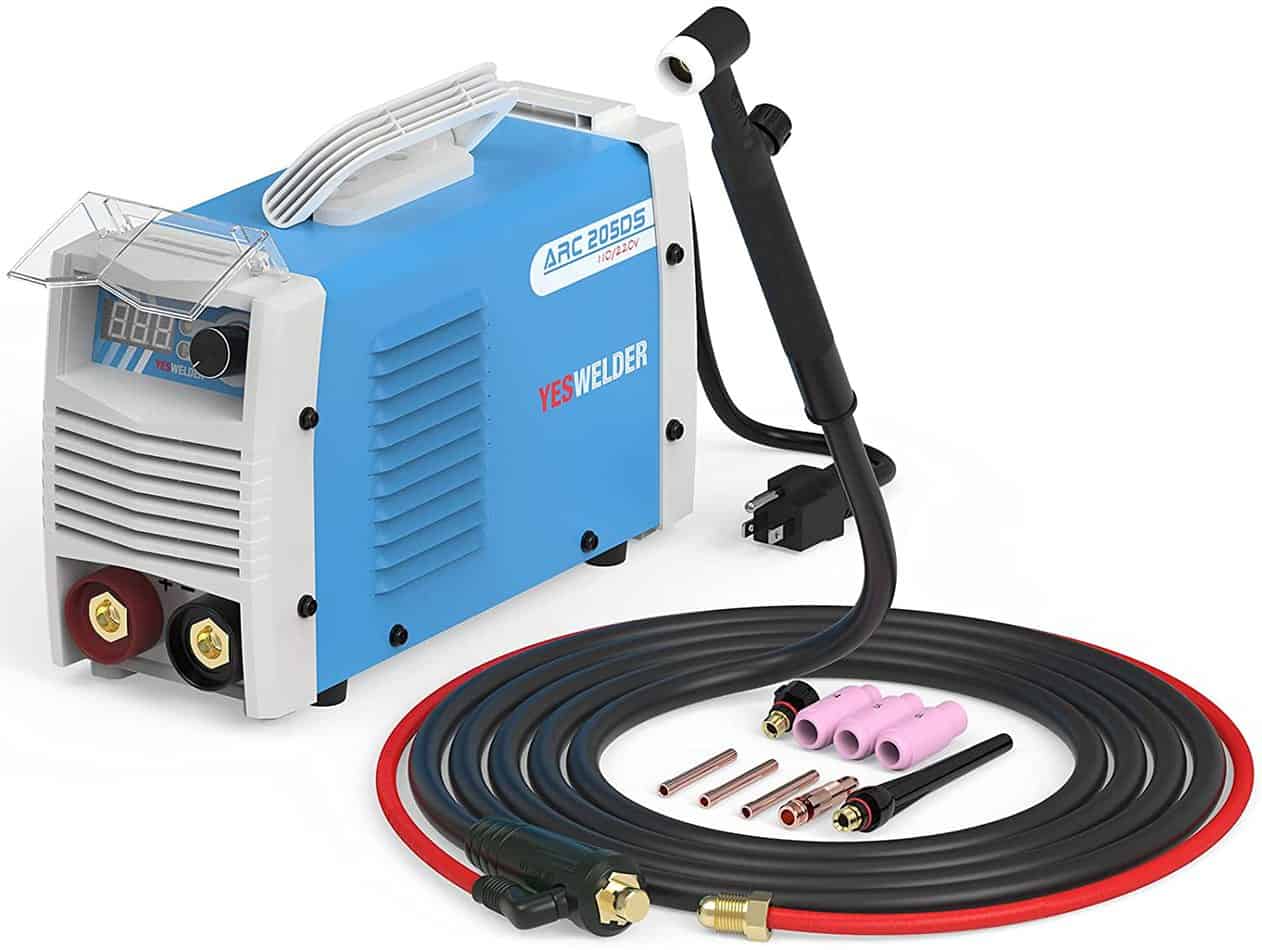
3. PrimeWeld CT520d Plasma Cutter / TIG Welder / Arc Welder Combo
This welder is more expensive than the other low-cost welders, but it comes with a bonus: in addition to welding TIG and arc, it also works as a plasma cutter. Buying this welder is cheaper than buying a TIG box and a separate plasma cutter. It welds at 200 amps and has a 60% duty cycle. It operates on 110 and 220-volt power.
Things we like:
- With the included plasma cutter, it’s a whole shop in a box. You just need the gas regulator and consumables to get going.
- Plenty of power to weld thicker steels
- Can TIG weld with a pedal
Things we don’t like:
- Can run on 110v power, but doesn’t come with a 110v plug
- Doesn’t come with a pedal for TIG
Best for:
This welder is great for someone who has never worked metal and doesn’t have any tools. Right out of the box, you can cut up metal, then TIG or stick weld it back together. It’s also an excellent machine for folks who work in other disciplines but occasionally need to do some metalwork (find it here on amazon).
Middle-Priced Welders
Welders in this price range have a lot more features for TIG welding than the budget models. They allow you more flexibility in setup and can handle a more extensive array of metals. If you want to weld aluminum, you need to buy a welder in this price range. These welders can either use alternating current or MIG, both of which work for aluminum.
4. LOTOS TIG200ACDC Welder (My Recommendation for TIG Enthusiasts)
With a max output of 225 amps and a 40% duty cycle, this welder is great for weekend warriors. It welds TIG and stick. The LOTOS TIG200ACDC can weld with alternating current for aluminum as well as direct current for steel. The welder comes with all the pieces needed for TIG and arc welding, including a pedal and a gas regulator.
Things we like:
- Comes with a pedal to regulate amperage on the fly
- Able to weld aluminum with alternating current
- Plenty of flexibility in controls lets you adjust the arc to your liking
- Customers report PrimeWeld has excellent customer service
- Includes a pulse weld feature that is usually limited to high-end welders
Things we don’t like:
- Plenty of flexibility in controls means lots of complexity for beginners
- Limited arc welding capability. It has presets for arc welding with specific rods. If you want to weld with a different rod, you are out of luck.
Best for:
This welder is best for someone who is serious about learning TIG welding. It gives a lot more control over the process than the low-budget welders. This makes it easy to adjust the arc, but it requires you to really understand the process. Limited capability for stick welding could be a problem for people who don’t just TIG weld. However, it is my top pick if you are focusing on TIG as a hobbyist.

My Recommendation for TIG Enthusiasts
5. Weldpro 200 Amp 3 in 1 Welder (My Recommendation for Home Repairs)
Weldpro’s flagship 200 amp welder is a combo machine that can weld MIG and stick as well as TIG. It has a 30% duty cycle at the full 200 amps. It comes with almost everything you need to weld except for the consumables. It does not come with a pedal for TIG welding.
Things we like:
- Ability to weld with MIG, TIG, and stick lets you pick the best process for any project.
- At 30 pounds, this welder is easily portable.
- 200 amp capacity lets you weld heavy steel.
Things we don’t like:
- This welder is optimized for MIG welding. The TIG features are limited
- No AC for welding aluminum.
- No pedal for easy arc control with TIG.
Best for:
The Weldpro 200 amp welder is best for someone who wants flexibility in welding. The ability to run MIG and stick processes as well as TIG means you can find a rod, MIG wire, or TIG set up for just about any project. It’s light enough to work on the go, and it is 110V compatible. On the other hand, if you want to specialize in TIG welding, this probably isn’t the best choice. However, the versatility makes it my top pick for welding beginners, because it will cover all your home repairs and has the best future-proof-to-cost ratio if you catch the welding bug. Amazon can hook you up here.
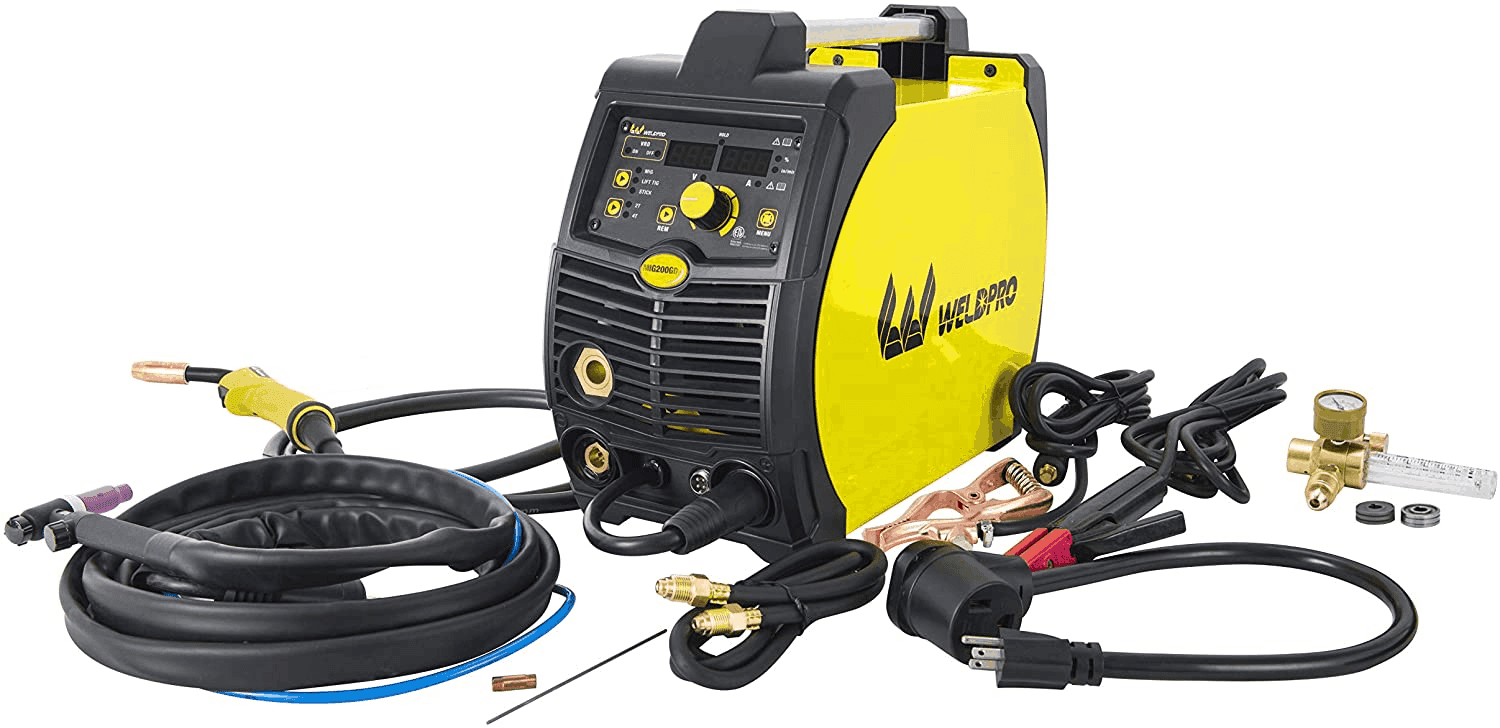
All Round Utility Machine, ideal for Home Repairs
High-End Welders
The last group of welders to look at are the high-end machines. These welders either come with lots of features, or a brand recognized for support and service, or both. These are the machines for serious metal workers who want to do a lot of TIG on just about every kind of metal.
6. Everlast PowerTIG 200 Amp Pulse AC/DC Welder
The PowerTIG 200 from Everlast is a serious TIG welder with lots of high-end features. It has a 200 amp output and a 60% duty cycle at max amperage. It is a TIG/stick combo welder that can run on 110 or 220 volts. The welder kit includes everything you need, including a pedal and gas regulator. It is capable of working with a water cooler for the torch, but one is not included.
Things we like:
- Plenty of power to weld steel up to 5/16 in a single pass
- Includes AC setting for welding aluminum
- Pulse welding feature lets you get full power while keeping metal cooler
- Very reasonable price for a welder with this set of features
- Analog dials for all settings give you complete control over the welding process
Things we don’t like:
- Analog dials for all settings can be overwhelming for brand-new metalworkers
- Everlast brand is new; it doesn’t have an established track record for durability, support, and service like other welders in this price range.
Best for:
This is a serious machine for a metalworker who wants to be able to TIG weld anything. You can control every setting of the weld to get the perfect arc. Like other high-end welders, it is pricey for someone who just wants to dip a toe in the TIG welding pool.
7. Hobart 500551 EZ-TIG Welder
One of the established names in welders is Hobart. They have a reputation for durable machines at an affordable price. If you prize durability above flexibility, this is the welder for you. It operates at a maximum of 165 amps and has a 20% duty cycle. It is a TIG-only machine with straightforward controls. It can use AC or DC, so welding aluminum is an option.
Things we like:
- Made in the USA
- Simple controls that are easy to use
- Comes with everything you need out of the box
- Hobart has an excellent reputation for durability and service
Things we don’t like:
- Limited features for a welder in this price range
- Simple controls make fine adjustments to the weld impossible
- TIG-only; won’t handle any other processes
- 20% duty cycle limits how much you can weld in one go
Best for:
This would be a great welder for a shop that doesn’t do a lot of welding but still needs a reliable machine. It would also be useful for a shop that consistently makes the same kind of weld. You could set it up, use it a little every day, and never have to think about getting a new welder again. It’s not a good choice for someone who welds a lot every day or someone who welds a little of everything.
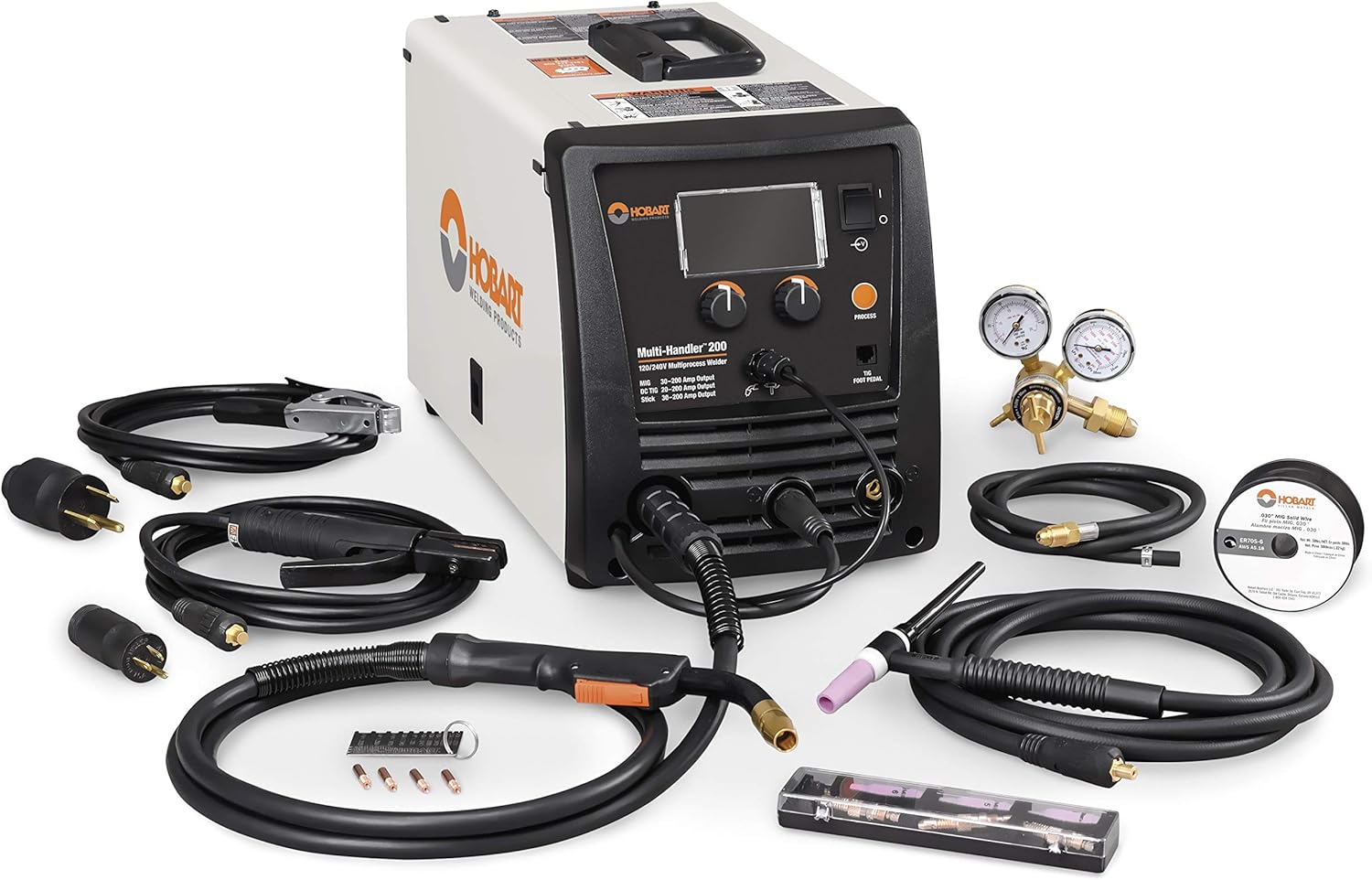
Top of the Range Option
8. Lincoln Electric Square Wave TIG 200 Welder
This TIG / stick combo machine has a maximum output of 200 amps and a 25% duty cycle at that level. It can weld with 110 or 220 volts. It has a pulsed weld capability as well as AC welding for aluminum. The controls are designed to be simple to operate, but it has lots of advanced features. Lincoln has an excellent reputation for durability and service, as well.
Things we like:
- Serious TIG welder can handle just about any TIG weld you have
- Easy to use, but enough capability to perform advanced work
- You won’t outgrow this welder, and you won’t wear it out either
Things we don’t like:
- All that capacity comes at a high price
Best for:
Serious TIG welders. This is the last TIG welder you will ever buy. It costs a lot, but Lincoln makes machines that are known for durability. You will probably break down and quit welding before this welder does.
9. Miller Diversion 180 TIG Welder
The Diversion 180 from Miller is a 180 amp, TIG-only welder with a 10% duty cycle at max amperage. It welds with both DC and AC and has an automatic, on-demand cooling fan. The welder comes with all the equipment needed for TIG welding, including the gas regulator and pedal. It has an easy-to-use interface that just requires you to input the metal type and thickness. The display will show the exact settings based on your entry.
Things we like:
- Like Lincoln welders, Miller machines are known for durability and support
- Interface is easy to set up but displays technical details. This gives both beginners and experienced welders what they need to get the most from the machine.
Things we don’t like:
- Very expensive for a beginner TIG welder
- TIG-only; no capacity for stick or MIG welding
Best for:
Everything we said about the Lincoln TIG 200 goes for the Miller Diversion 180, as well. This is an expensive TIG-only machine that will last a long time. Most home welders are unlikely to find anything this welder won’t handle. You can set it up and forget about buying another welder.
My Shortlist
If you are on a tight budget, spring for the PrimeWeld CT520d Plasma Cutter / TIG Welder / Arc Welder Combo. Buying this welder is less expensive than purchasing a separate welder and plasma cutter or torch. You will need to be able to cut steel before you can weld, and plasma cutters make cutting a breeze.
If you want to weld aluminum, or you can spring for a middle-price welder, we like the Weldpro 200 Amp 3 in 1 Welder. With the ability to MIG and arc weld as well as TIG, this machine will do it all. You won’t find a project that this welder can’t handle.
If you want a serious TIG welder for everyday use, check out the Everlast PowerTIG 200 Amp Pulse AC/DC Welder. It has a lot of high-end features and offers complete control of every part of the welding process. With this welder, you can dial up a combo that will TIG weld just about anything.
Whatever welder you choose, the most crucial part of learning to TIG weld is welding. Find some projects you want to make, buy some steel, and crack an arc. You can’t get good at welding until you try it!

